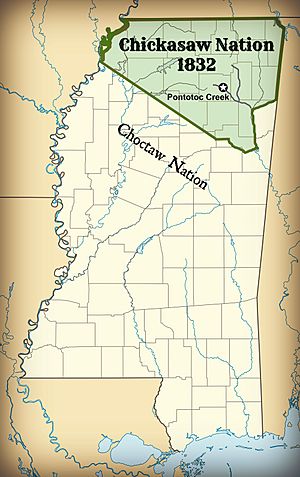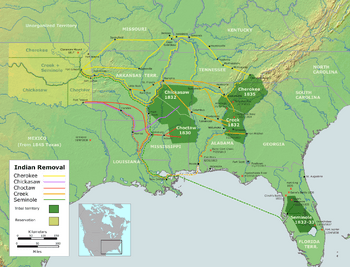Treaty of Pontotoc Creek facts for kids
The Treaty of Pontotoc Creek was an agreement signed on October 20, 1832. It was made between the United States government and the leaders of the Chickasaw Nation. This meeting happened at the National Council House on Pontotoc Creek in Pontotoc, Mississippi.
In this treaty, the Chickasaw Nation gave up over 6 million acres of their homeland in Mississippi. In return, they were promised new land of the same size west of the Mississippi River.
An earlier agreement to move west had been made in 1830. However, the Chickasaw refused to move then. They found out the new land was not good. But the state of Mississippi was putting a lot of pressure on them. Mississippi wanted to control the Native American lands. So, in 1832, the Chickasaw leaders agreed to President Andrew Jackson's offer to move west. The land was given to the U.S. government. The money from selling this land to white settlers was supposed to go to the Chickasaw. This treaty led to the Chickasaw Trail of Tears. The entire Chickasaw Nation moved to new territory in what is now Oklahoma between 1837 and 1838.
Contents
Why the Treaty Happened
This treaty was part of a bigger plan called Indian Removal. President Thomas Jefferson first suggested this idea. The plan was for the Five Civilized Tribes to move west of the Mississippi River. This would allow white settlers to move into their lands in the southern United States.
The Treaty of Pontotoc Creek was one of several treaties signed in the 1830s. Other tribes like the Muscogee, Choctaw, and Cherokee also signed similar agreements. They all moved to new lands in what is now Oklahoma and Arkansas. The Chickasaw were likely to be moved because of a promise made in 1806. President Jefferson had told southern states that the government would encourage all Native Americans to move west.
Another reason for moving Native Americans was land speculation. This means buying land hoping its price would go up. It was a main way for wealthy landowners in the South to make money. Andrew Jackson, John Coffee, and James Jackson (who were not related) were all involved in land speculation. They were also military leaders and politicians. They worked to get large areas of Native American land. They also helped defeat Native American resistance. Eventually, they helped move the Chickasaw and other tribes to make way for white settlers. They often made a lot of money from this.
Early Attempts to Move the Chickasaw
Before the Pontotoc Creek Treaty, the Chickasaw had already given up some land. They made two big agreements in 1805 and 1816. They gave up land in Alabama and Tennessee along the Tennessee River. This included the valuable Muscle Shoals area. Jackson, Coffee, and James Jackson made a lot of money from these land deals. James Jackson even built his large Forks of Cypress Plantation on this land.
In 1818, Jackson tried to move the Chickasaw completely. He wanted a treaty that would give up all land between the Tennessee River and the Mississippi River. John C. Calhoun, who worked for President Monroe, told Jackson that the President really wanted to move Native Americans west. He said it would be best if the Chickasaw would trade their land. This land was very valuable because it had good soil and salt licks. The Chickasaw knew its value.
Jackson convinced James Colbert and other Chickasaw leaders to meet him. They met at Chickasaw Old Town (now Tupelo, Mississippi). They talked about giving up land. Powerful Chickasaw leaders like James, George, and Levi Colbert had a big influence. They owned land and had adopted some ways of plantation society. They supported moving west.
Jackson finally convinced the Chickasaw leaders to agree. He promised them $20,000 each year for fifteen years. A legal paper was made in James Jackson's name. This showed how these land deals could be unfair. The Chickasaw lost all their land north of the Mississippi border with Tennessee. Andrew Jackson got a huge amount of land. But he did not get the total move west that he wanted. The Chickasaw carefully protected their remaining land until Jackson became President.
The Treaty of Pontotoc Creek, 1832
After Jackson was elected President in 1828, he wanted to finish the issue of moving Native Americans. The Indian Removal Act was passed in May 1830. This law gave the President direct power to arrange treaties for the Five Civilized Tribes. These tribes were still living in their homelands in the Southeast.
The Treaty of Franklin, 1830
After the Indian Removal Act, Jackson faced strong legal challenges from the Creeks and Cherokees. The Choctaw Chief Greenwood LeFlore refused to meet with the President. However, the Chickasaw agreed to meet Jackson in Franklin, Tennessee in the summer of 1830.
By this time, the state of Mississippi was treating the Chickasaw and Choctaw in the same way Georgia treated the Cherokee. Mississippi was basically stopping tribal governments from working. It was also extending state laws over the Chickasaw Nation's borders. The Chickasaw came to Franklin to ask Jackson for help from the federal government against Mississippi.
Jackson, however, convinced the leaders to agree to move. He told them that if they stayed in Mississippi, they would be under Mississippi law. He said their culture would disappear as white settlers moved in. He told them: "If you mix with the white people, your national identity will be lost... you will disappear and be forgotten." On August 27, 1830, after four days of talks, the Chickasaw leaders agreed to trade their land in Mississippi and move west.
Renegotiation and Pontotoc Creek
A group of Chickasaw was sent to explore the new territory west of the Mississippi. They delayed the move for two more years, which bothered Jackson. They returned to the Chickasaw in Mississippi and said the new land was not good for their people. The Senate refused to approve the Franklin treaty. The Chickasaw also refused to leave their land in Mississippi.
For two more years, the Chickasaws stayed in Mississippi. But their determination began to weaken. More and more non-Chickasaw people were settling on Chickasaw lands without permission. Also, Mississippi state laws were challenging the Chickasaw's right to govern themselves.
In 1832, the Chickasaw National Council agreed to meet with John Coffee. They wanted to negotiate a new land transfer treaty. On October 20, 1832, they met at the Council House on Pontotoc Creek. Chickasaw leaders signed a treaty. This treaty allowed for the sale of Chickasaw lands in Mississippi. In return, new lands in the west would be surveyed for them.
The Chickasaw leaders wrote a statement at the beginning of the treaty. It said that the Chickasaw Nation felt pressured by being under the laws of the states where they lived. They did not understand these laws. So, they preferred to find a home in the west where they could live under their own laws. They believed they could find and pay for a suitable home if they had the money. So, they decided to sell their land and find a new home. The President heard their complaints. He also believed they could not be happy as a nation if they stayed. He wanted to help them avoid a great disaster. So, he sent his Commissioner, General John Coffee. Coffee met with the whole Chickasaw Nation. After much thought, they agreed to the articles in the treaty.
Even though there were more issues to solve, the Pontotoc Creek Treaty was very important. It was the main document for moving the Chickasaw. It arranged for them to give up all their tribal land east of the Mississippi River. In the treaty, the Chickasaw gave up their land. In return, the U.S. government would find suitable land for them to move to. This showed how desperate the leaders were to get back their power from Mississippi.
Chickasaw landowners were to be paid for any improvements they made on their lands. All the money the government made from selling the land was to go to the Chickasaw. This money would pay for finding new territory and for moving the tribe. Unlike other treaties, the Chickasaw would pay for their own move. The treaty also protected the Chickasaw in Mississippi until they moved. They were given "temporary homesteads." This meant the Chickasaws could keep the land they lived on in Mississippi. The federal government would protect them from people settling on their land without permission. The Cherokee did not get this benefit later on.
What Happened Next
Right after the treaty, white settlers quickly moved onto Chickasaw land that was not assigned to anyone. This happened even though the treaty said they were not supposed to enter until the Chickasaw moved.
Between 1832 and 1837, the Chickasaw made more agreements. This was partly because the Senate was slow to approve the Pontotoc Treaty. It was also because the Chickasaws were not happy with the new land they were finding. The Treaty of Washington in 1834 confirmed the Pontotoc Treaty. It also allowed the Chickasaw temporary homesteads to be larger and sold. It promised the Chickasaw would get the money for each improved homestead sold. The leaders wanted to get the best deal for selling their land and getting new land for their people.
New Land in the West, Treaty of Doaksville 1837
After the Pontotoc Treaty, Chickasaw groups went to look for new land in the Arkansas Territory. They reached an agreement with the Choctaw in 1837. The Chickasaw decided to buy part of the Choctaw tribe's new western land. This agreement became known as the Treaty of Doaksville. They paid $530,000 for it. Even though this treaty was between two Native American nations, Andrew Jackson convinced the Senate to approve it. So, the Chickasaw gave up their eastern land with the Treaty of Pontotoc Creek. Then, they bought western land from the Choctaw in the Treaty of Doaksville.
The Chickasaw Trail of Tears
In 1837-1838, the Chickasaw had bought their western lands from the Choctaw. About 4,914 Chickasaw people and 1,156 of their enslaved people moved to the new Chickasaw Nation in the west. They received over $3 million from the sales of their Mississippi lands. But with this wealth, they faced new threats. White opportunists came to the new Chickasaw territory as surveyors and salesmen.
The Chickasaw Trail of Tears was less difficult than the journeys of other tribes. It was more successful compared to the Choctaw or Cherokee moves. However, it still harmed the tribe's culture and structure. It took many decades for them to recover.



